Chemical And Biological Oceanography
-
- Boat of the Month Marine News, Mar 2014 #42
Alion & Robert Allan Team up to Deliver High Tech Research Vessel
In the very near future, the new scientific Research Vessel Investigator will enter service for the Commonwealth Scientific and Industrial Research Organization (CSIRO), an agency of the Federal Government of Australia. Investigator went to sea for her initial sea trials in December 2013. Once deployed, Investigator will be among the quietest and most capable research vessels in the world, serving multiple, diverse scientific roles in a geographical areas spanning one-third the circumference of the globe.
The design was developed by RALion, a joint venture between Vancouver BC Naval Architects, Robert Allan Ltd, Alion Science and Technology of Alexandria, Virginia and Alion Canada of Ottawa. The acoustic analysis, noise treatments and noise trial measurements were performed by Noise Control Engineering of the US. The vessel was launched on July 21st, 2013 and then officially named Investigator at a ceremony in Singapore in September.
The vessel will potentially raise the bar for science vessels – here and abroad – in a sector where research vessels often emanate from platforms not originally designed for the purpose. Moreover, financial constraints for research organizations, universities and other government efforts often do not allow for the most environmentally correct equipment. Investigator changes that mindset. Described loosely as a combination of the large AGOR’s (23 & 24) class built in 1990’s and the NOAA fishery science vessels built at Halter and Marinette, the vessel’s price tag was said to be in the range of $125 million, the high end of what is typically spent on this type of vessel. That said; Investigator is a scientist’s dream platform, with virtually every bell and whistle the research community could possibly want. Investigator is classed by Lloyds Register of Shipping as a +100A1, +LMC, UMS Ice 1C IWS, EP, DP (AM) and DNV SILENT-R research vessel.
Designed to meet the underwater radiated noise requirements of the DNV “Silent R” notation up to 11 knots, this capability allows the vessel to undertake sensitive environmental research. A low radiated noise signature is critical for vessels engaged in fisheries and marine mammal research to avoid disturbing the habitats they are studying. A low noise signature is also crucial to ensuring that the vessel’s large suite of scientific survey sonars has the capability to reach the greatest depths of the world’s oceans. To meet this stringent underwater radiated noise level, a comprehensive program of noise control engineering and production practices was established. For example, all three MaK main diesel generators are double resiliently mounted on an isolation system engineered by NCE and RALion and supplied by MaK. This mounting system is specifically designed to absorb vibration. And, the Wartsila 5-bladed propellers have a unique blade shape specially designed to be free of cavitation up to 12 knots. During the sea trial, Investigator was found to have exceeded all of her noise requirements, including radiated, habitability, and structural vibration.
Investigator is fitted out with a full range of scientific laboratories, science and fishing winches, coring equipment, air and water sampling devices, and acoustic systems. She is capable of a variety of oceanographic operations in coastal and deep ocean areas, including the physical, chemical and biological oceanography, environmental investigations, ocean engineering and marine acoustics, coastal hydrographic survey, marine geology and geophysics, bathymetric surveys and fisheries research. An interesting feature is the vessel’s gondola and two retractable drop keels to house the extensive scientific sonar and transducer suites, supplied by Kongsberg. The vessel is fitted with a stern ramp and towing gallows to support fisheries research activities.
The vessel potentially represents the new benchmark for global research vessels. With its Tier II engines, self contained (zero discharge at sea) sewage treatment system and other green features, it also sets a new standard for environmental stewardship, consistent with the mission of such a vessel. The vessel enters service, fully commissioned, less than three years after award of the design and construction contract; a remarkable feat given the size and complexity of this ship.
www.alionscience.com / www.ral.ca
(As published in the March 2014 edition of Marine News - www.marinelink.com)
-
- Australia’s Largest Research Vessel Ready for Launch Marine Technology, Jan 2014 #14
acoustic systems. It is capable of general-purpose oceanographic survey operations in coastal and deep ocean areas, including the physical, chemical and biological oceanography, multi-discipline environmental investigations, ocean engineering and marine acoustics, coastal hydrographic survey, marine geology
-
 )
March 2024 - Marine Technology Reporter page: 45
)
March 2024 - Marine Technology Reporter page: 45ronments. The new agreement will address speci? c techni- cal gaps in the UUV defense and offshore energy markets especially for long duration, multi-payload mission opera- tions where communications are often denied or restricted. As part of the new alliance, Metron’s Resilient Mission Autonomy portfolio
-
 )
March 2024 - Marine Technology Reporter page: 37
)
March 2024 - Marine Technology Reporter page: 37miscible barrier ? uid heavier than seawater (sg=1.026) and lighter than the battery electrolyte (sg=1.265). The original cell vent cap was screwed into the top of the riser pipe to vent the gases associated with charging. Wires were soldered to the lead (Pb) posts. The lead-acid battery was additionall
-
 )
March 2024 - Marine Technology Reporter page: 36
)
March 2024 - Marine Technology Reporter page: 36LANDER LAB #10 Of special interest for marine applications, LiPo batteries are Shipping any kind of lithium battery can be a challenge, and offered in a “pouch” design, with a soft, ? at body. The pouch IATA regs vary with the batteries inside or outside an instru- is vacuum-sealed, with all voids ?
-
 )
March 2024 - Marine Technology Reporter page: 34
)
March 2024 - Marine Technology Reporter page: 34be recharged, known as cycle life. BATTERY BASICS FACTORS EFFECTING CAPACITY A cell generates electrical power through two galvanically Batteries work on chemical reactions. The chemical reaction active materials immersed in a conducting electrolyte. The rates are largely driven by temperature. The colder
-
 )
March 2024 - Marine Technology Reporter page: 25
)
March 2024 - Marine Technology Reporter page: 25Auerbach explained that ideally, “one ? ed layers of geothermal activity,” noted changes over an area of 8,000 km2. They would have both instruments: seismom- Skett, “and the change in salinity and dis- found up to seven km3 of displaced ma- eters to detect and locate subsurface ac- solved particles for
-
 )
March 2024 - Marine Technology Reporter page: 23
)
March 2024 - Marine Technology Reporter page: 23underwater forests.” These for- ests are a hotspot of biodiversity and species richness. Underwater eruptions are also known to change the chemical nature of the ocean in the vicinity, creating localized disruptions to the oceanic food chain. DETECTING “Most volcanic activity in the world occurs
-
 )
March 2024 - Marine Technology Reporter page: 13
)
March 2024 - Marine Technology Reporter page: 13nyone familiar with glider hardware options integrated for a broad Glider answers that need,” said Shea autonomous underwater ve- range of missions. Quinn, Slocum Glider Product Line hicles (AUVs) is certainly “As the use of Slocum Gliders grew, Manager at TWR. A familiar with the popular- so did
-
 )
March 2024 - Marine Technology Reporter page: 6
)
March 2024 - Marine Technology Reporter page: 6MTR Editorial Advisors Gallaudet Hardy The Honorable Tim Gallaudet, Kevin Hardy is President PhD, Rear Admiral, U.S. of Global Ocean Design, Navy (ret) is the CEO of creating components and Ocean STL Consulting and subsystems for unmanned host of The American Blue vehicles, following a career
-
 )
April 2024 - Maritime Reporter and Engineering News page: 13
)
April 2024 - Maritime Reporter and Engineering News page: 13. It is technically stupid, and quite long term carbon fuel use. frankly also economically unattractive from the driver’s point of If a liquid or other chemical fuel is needed, 7. view, since it simply increases their cost for getting from A to B. provide equipment that can use fuels that can As a
-
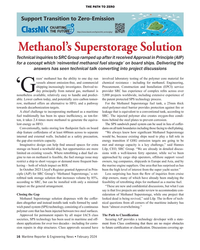 )
February 2024 - Maritime Reporter and Engineering News page: 16
)
February 2024 - Maritime Reporter and Engineering News page: 16methanol has the ability to one day run involved laboratory testing of the polymer core material for vessels almost emission-free, and commercial chemical resistance - including for methanol. Engineering, shipping increasingly investigates. Derived to- Procurement, Construction and Installation (EPCI)
-
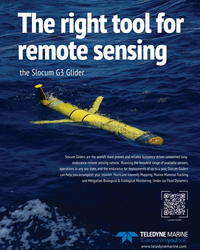 )
January 2024 - Marine Technology Reporter page: 4th Cover
)
January 2024 - Marine Technology Reporter page: 4th CoverThe right tool for remote sensing the Slocum G3 Glider Slocum Gliders are the world’s most proven and reliable buoyancy-driven unmanned long- endurance remote sensing vehicle. Boasting the broadest range of available sensors, operations in any sea state, and the endurance for deployments of up to a year
-
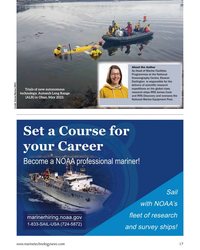 )
January 2024 - Marine Technology Reporter page: 17
)
January 2024 - Marine Technology Reporter page: 17About the Author As Head of Marine Facilities Programmes at the National Oceanography Centre, Eleanor Darlington is responsible for the delivery of scienti? c research expeditions on the global class Trials of new autonomous research ships RRS James Cook technology, Autosub Long Range and RRS
-
 )
January 2024 - Marine Technology Reporter page: 14
)
January 2024 - Marine Technology Reporter page: 14INSIGHTS SCIENCE RESEARCH MANAGEMENT © Who is Danny/AdobeStock PAVING THE WAY IN INTERNATIONAL SCIENCE RESEARCH MANAGEMENT Dr. Eleanor Darlington, Head of Marine Facilities Programs at the National Oceanography Centre (NOC), discusses how NOC is paving the way in international science research
-
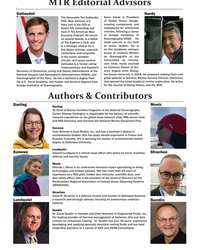 )
January 2024 - Marine Technology Reporter page: 6
)
January 2024 - Marine Technology Reporter page: 6MTR Editorial Advisors Gallaudet Hardy The Honorable Tim Gallaudet, Kevin Hardy is President PhD, Rear Admiral, U.S. of Global Ocean Design, Navy (ret) is the CEO of creating components and Ocean STL Consulting and subsystems for unmanned host of The American Blue vehicles, following a career
-
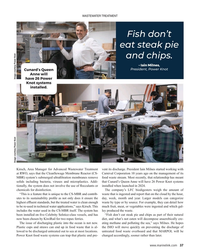 )
January 2024 - Maritime Reporter and Engineering News page: 37
)
January 2024 - Maritime Reporter and Engineering News page: 37Cunard’s Queen Anne will have 26 Power Knot systems tionally, the system does not involve the use of ? occulants or installed when launched in 2024. chemicals for disinfection. The company’s LFC biodigesters weigh the amount of “This is a feature that is unique to the CS-MBR and contrib- waste that is
-
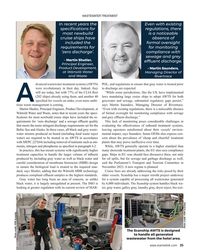 )
January 2024 - Maritime Reporter and Engineering News page: 35
)
January 2024 - Maritime Reporter and Engineering News page: 35WASTEWATER TREATMENT In recent years the Even with existing speci? cations for regulations, there most newbuild is a noticeable cruise ships have absence of included the formal oversight requirements for for monitoring ‘zero discharge’. compliance with sewage and grey – Martin Shutler
-
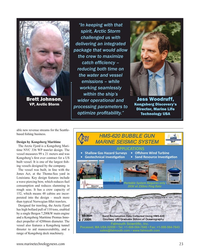 )
November 2023 - Marine Technology Reporter page: 23
)
November 2023 - Marine Technology Reporter page: 23“In keeping with that spirit, Arctic Storm challenged us with delivering an integrated package that would allow the crew to maximize catch ef? ciency – reducing both time on the water and vessel emissions – while working seamlessly within the ship’s Brett Johnson, Jess Woodruff, wider operation
-
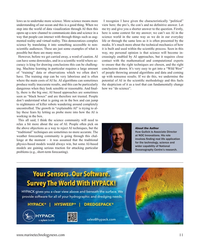 )
November 2023 - Marine Technology Reporter page: 11
)
November 2023 - Marine Technology Reporter page: 11lows us to undertake more science. More science means more I recognize I have given the characteristically “political” understanding of our ocean and this is a good thing. When we view here; the pro’s, the con’s and no de? nitive answer. Let step into the world of data visualization through AI then
-
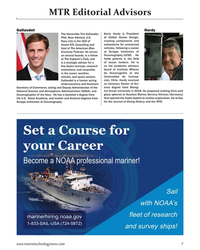 )
November 2023 - Marine Technology Reporter page: 7
)
November 2023 - Marine Technology Reporter page: 7MTR Editorial Advisors Gallaudet Hardy The Honorable Tim Gallaudet, Kevin Hardy is President PhD, Rear Admiral, U.S. of Global Ocean Design, Navy (ret) is the CEO of creating components and Ocean STL Consulting and subsystems for unmanned host of The American Blue vehicles, following a career
-
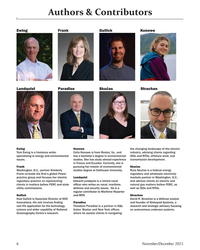 )
November 2023 - Marine Technology Reporter page: 6
)
November 2023 - Marine Technology Reporter page: 6Authors & Contributors Frank Ewing Gullick Konowe Skucas Lundquist Paradise Strachan Ewing Konowe the changing landscape of the electric Tom Ewing is a freelance writer Celia Konowe is from Reston, Va., and industry, advising clients regarding specializing in energy and environmental has a bachelor’s
-
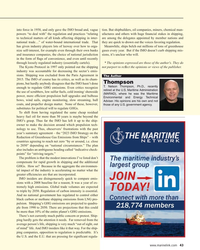 )
December 2023 - Maritime Reporter and Engineering News page: 43
)
December 2023 - Maritime Reporter and Engineering News page: 43into force in 1958, and only gave the IMO broad and, vague tion. But shipbuilders, oil companies, miners, chemical man- powers “to deal with” the regulation and practices “relating ufactures and others with huge ? nancial stakes in shipping, to technical matters of all kinds affecting shipping in inter-
-
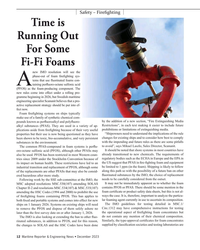 )
December 2023 - Maritime Reporter and Engineering News page: 12
)
December 2023 - Maritime Reporter and Engineering News page: 12that a pro- active replacement strategy should be put into ef- fect now. Foam ? re? ghting systems on ships typically make use of a family of synthetic chemical com- by the addition of a new section, “Fire Extinguishing Media pounds known as per? uoroalkyl and poly? uoro- Restrictions”, in each text making
-
 )
November 2023 - Marine News page: 29
)
November 2023 - Marine News page: 29, stressed in her remarks that ammonia is widely available and traded with a well-devel- oped infrastructure. Fellow panelist Captain Don Carroll, from chemical tanker owner MT Maritime, sought to dispel issues related to safe handling of ammonia, saying, “We handle it all time; we are very familiar with
-
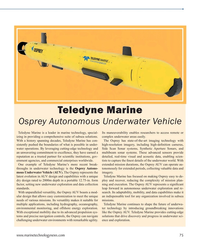 )
September 2023 - Marine Technology Reporter page: 75
)
September 2023 - Marine Technology Reporter page: 75Teledyne Marine Osprey Autonomous Underwater Vehicle Teledyne Marine is a leader in marine technology, special- Its maneuverability enables researchers to access remote or izing in providing a comprehensive suite of subsea solutions. complex underwater areas easily. With a history spanning decades,
